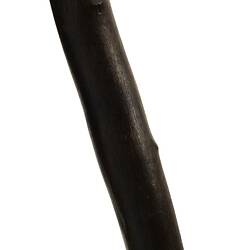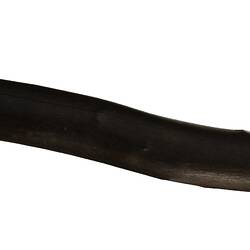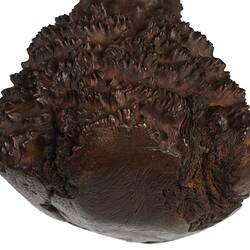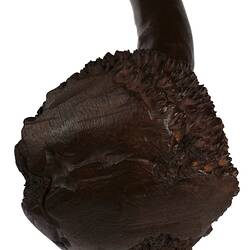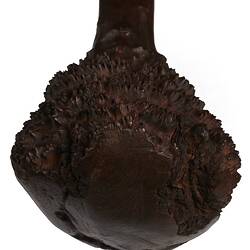Summary
This club is a very large and heavy weapon. Made by a Peramangk man from the Mount Lofty Ranges in South Australia, it has been skillfully fashioned to utilize the shape of the tree root it was carved from and features a bulbous head flattened on one side.
The Peramangk people were sometimes referred to in colonial times as 'The Mount Lofty Tribe' due to large numbers of their peoples being often sighted on the eastern escarpment of the Adelaide Hills and in the districts surrounding Mt Barker in South Australia. Their traditional lands extend north from Mount Barker through Harrogate, Gumeracha, Mt Pleasant, and Springton to the Angaston district and south to Strathalbyn. The Peramangk people share borders and close relationships, aspects of culture, trade and language with the Kaurna Nation to the west, the Ngadjuri Nation to the north, the Ngarrindjeri Nation to the south and the Meru Nation to the east.
The Peramangk people referred to Mt Barker summit area as womma-mukurta which means 'hill on a plain' and the nearby town now called Hahndorf was a favoured camping place for countless generations.
The diet of the Peramangk people fluctuated with the traditional laws of seasons and permissions of access with their neighbours but was primarily made up of vegetables, seeds, honey, eggs, grubs, insects, lizards, snakes, fish, yabbies, opossums and sometimes larger game including kangaroo, wallaby and emu.
Although the Peramangk were greatly affected by the ravages of colonisation many Peramangk people continue to live and celebrate their culture in South Australia today. The Imbala Jarjun Dance Company celebrate their Peramangk culture and stories through live music and dance performance as well as hosting educational workshops for the wider South Australian community to learn about Peramangk bush tucker, art and traditional dance.
Physical Description
Very large club with a bulbous tree root head. The shaft is irregularly curved and the cross section of the shaft is circular. Hand grip roughened near proximal end. Technique is carved and incised.
Significance
Aboriginal men in south eastern Australia fashioned clubs from hardwood such as blackwood, wattle, ironbark, red box, or sheoak, depending on the species of tree growing on their country. They carefully select branches or roots that would provide a weapon perfectly balanced and sized to suit their stature and strength. The Peramangk warrior who made this extraordinary weapon must have been a man of great strength to wield such a heavy club.
Clubs were used by men for fighting and hunting. Given the bulbous head, the irregular curve of the shaft and the handgrip shaped into the weapon's body, this heavy club was more than likely used in battle to deliver a mighty and debilitating blow.
More Information
-
Object/Medium
Club
-
Maker
-
Cultural Groups
-
Locality
-
Date Produced
-
Collector
-
Object Measurements
650 mm (Length), 140 mm (Width), 130 mm (Height)
-
Classification
-
Date Made
-
Maker
-
Clan/Language Group
-
Place Made
-
Indigenous Region
-
Keywords
-
Collection Names
-
Type of item
-
Discipline
-
Category
-
Collecting Areas

